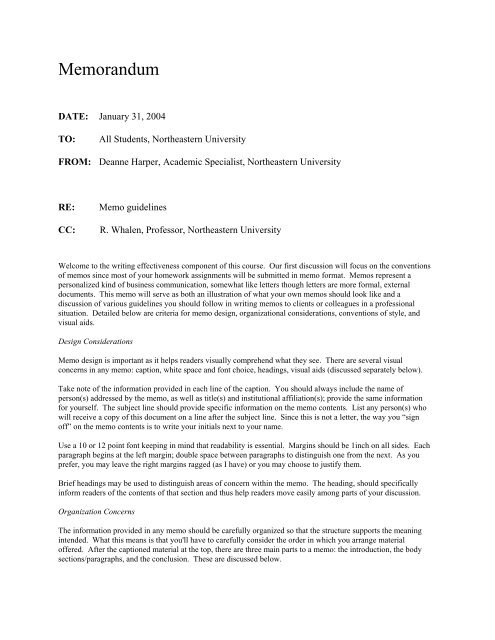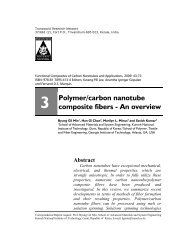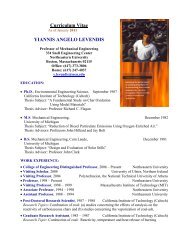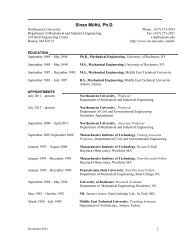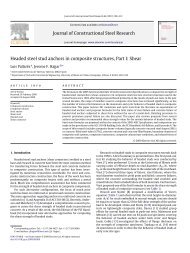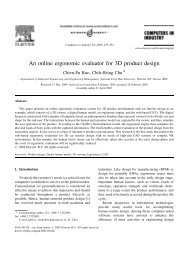Memo Format - Northeastern University
Memo Format - Northeastern University
Memo Format - Northeastern University
You also want an ePaper? Increase the reach of your titles
YUMPU automatically turns print PDFs into web optimized ePapers that Google loves.
<strong>Memo</strong>randum<br />
DATE: January 31, 2004<br />
TO: All Students, <strong>Northeastern</strong> <strong>University</strong><br />
FROM: Deanne Harper, Academic Specialist, <strong>Northeastern</strong> <strong>University</strong><br />
RE: <strong>Memo</strong> guidelines<br />
CC: R. Whalen, Professor, <strong>Northeastern</strong> <strong>University</strong><br />
Welcome to the writing effectiveness component of this course. Our first discussion will focus on the conventions<br />
of memos since most of your homework assignments will be submitted in memo format. <strong>Memo</strong>s represent a<br />
personalized kind of business communication, somewhat like letters though letters are more formal, external<br />
documents. This memo will serve as both an illustration of what your own memos should look like and a<br />
discussion of various guidelines you should follow in writing memos to clients or colleagues in a professional<br />
situation. Detailed below are criteria for memo design, organizational considerations, conventions of style, and<br />
visual aids.<br />
Design Considerations<br />
<strong>Memo</strong> design is important as it helps readers visually comprehend what they see. There are several visual<br />
concerns in any memo: caption, white space and font choice, headings, visual aids (discussed separately below).<br />
Take note of the information provided in each line of the caption. You should always include the name of<br />
person(s) addressed by the memo, as well as title(s) and institutional affiliation(s); provide the same information<br />
for yourself. The subject line should provide specific information on the memo contents. List any person(s) who<br />
will receive a copy of this document on a line after the subject line. Since this is not a letter, the way you “sign<br />
off” on the memo contents is to write your initials next to your name.<br />
Use a 10 or 12 point font keeping in mind that readability is essential. Margins should be 1inch on all sides. Each<br />
paragraph begins at the left margin; double space between paragraphs to distinguish one from the next. As you<br />
prefer, you may leave the right margins ragged (as I have) or you may choose to justify them.<br />
Brief headings may be used to distinguish areas of concern within the memo. The heading, should specifically<br />
inform readers of the contents of that section and thus help readers move easily among parts of your discussion.<br />
Organization Concerns<br />
The information provided in any memo should be carefully organized so that the structure supports the meaning<br />
intended. What this means is that you'll have to carefully consider the order in which you arrange material<br />
offered. After the captioned material at the top, there are three main parts to a memo: the introduction, the body<br />
sections/paragraphs, and the conclusion. These are discussed below.
An important concern in any document is that you orient your reader before proceeding with your detailed<br />
discussion of each of the parts or sections you present. The introductory paragraph should establish the context of<br />
the discussion and give the reader a "roadmap" or overview of what is to follow and how it is organized (see my<br />
introductory paragraph above). It is not necessary to label the introduction in a piece as short as this, though you<br />
may choose to do so in longer documents such as reports.<br />
After the introduction, the main component of the memo is a series of body paragraphs, perhaps arranged into<br />
discrete sections identified with a heading (as discussed above). Each of these paragraphs should detail results or<br />
other requested information, and also explain the significance of the information provided as well as its relation to<br />
other areas of discussion, as appropriate.<br />
The conclusion is important if for no other reason than that it signals to the reader that you have indeed come to<br />
the end of your comments. The two conventions of a conclusion are (1) a cordial close, reaffirming the personal<br />
nature of the communication, and (2) an offer to be of further assistance that includes, as a matter of courtesy,<br />
numbers or addresses to aid further contact. See my conclusion, below, for an example of this.<br />
Style<br />
<strong>Memo</strong>s are personal but not chatty, so the tone and language you choose should reflect your technical and<br />
professional expertise but should not be overly formal. My own sentences are sufficiently formal with a<br />
professional tone. Sentences must be grammatically correct. Use different kinds of sentences: some short, some<br />
complex. You will always need to be aware of your audience as you write as this awareness helps you choose the<br />
appropriate language to use. Word choice issues include incorporation of strong and precise verbs, selective use<br />
of passive voice, correct placement and punctuation of modifying phrases, precise pronoun references. You<br />
should work to be as concise as possible and to avoid sexist or discriminatory language.<br />
Visual Aids<br />
Use visual aids whenever they will be useful to illustrate and/or clarify information. Visuals are labeled as figures<br />
(photographs, diagrams, drawings) or tables (which arrange and simplify presentation of numbers or variables. It<br />
is most important to remember to identify each visual by number in the order in which it appears in your text: the<br />
first figure is Figure 1. In addition to the numbering, however, each visual should be informatively titled. The<br />
visual should be placed as near to the discussion as possible and should be explicitly discussed in the text. A<br />
visual does not replace discussion: speak, at least briefly, of what the reader will find as s./he looks at the visual<br />
aid.<br />
I hope this brief overview proves useful as you prepare <strong>Memo</strong>s for this class. Should you have questions about<br />
this material that I cannot answer in class, please feel free to contact me in any of the following ways:<br />
phone - 373-2493<br />
email - d.harper@nunet.neu.edu<br />
office - 283 Ryder Hall<br />
In addition, I have a website where I provide more specific information (and examples) of the various concerns<br />
discussed above (http://www.dac.neu.edu/sgs/d.harper). I look forward to working with you this term, and I wish<br />
you the best of luck with your work.


